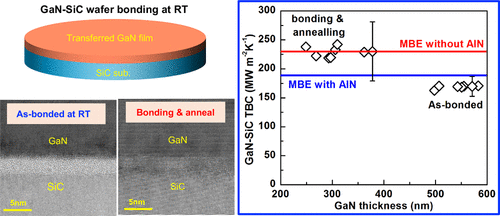当前位置:
X-MOL 学术
›
ACS Appl. Mater. Interfaces
›
论文详情
Our official English website, www.x-mol.net, welcomes your
feedback! (Note: you will need to create a separate account there.)
High Thermal Boundary Conductance across Bonded Heterogeneous GaN–SiC Interfaces
ACS Applied Materials & Interfaces ( IF 8.3 ) Pub Date : 2019-08-13 00:00:00 , DOI: 10.1021/acsami.9b10106 Fengwen Mu 1, 2 , Zhe Cheng , Jingjing Shi , Seongbin Shin 1 , Bin Xu 3 , Junichiro Shiomi 3 , Samuel Graham , Tadatomo Suga 1
ACS Applied Materials & Interfaces ( IF 8.3 ) Pub Date : 2019-08-13 00:00:00 , DOI: 10.1021/acsami.9b10106 Fengwen Mu 1, 2 , Zhe Cheng , Jingjing Shi , Seongbin Shin 1 , Bin Xu 3 , Junichiro Shiomi 3 , Samuel Graham , Tadatomo Suga 1
Affiliation

|
High-power GaN-based electronics are limited by high channel temperatures induced by self-heating, which degrades device performance and reliability. Increasing the thermal boundary conductance (TBC) between GaN and SiC will aid in the heat dissipation of GaN-on-SiC devices by taking advantage of the high thermal conductivity of SiC substrates. For the typical growth method, there are issues concerning the transition layer at the interface and low-quality GaN adjacent to the interface, which impedes heat flow. In this work, a room-temperature bonding method is used to bond high-quality GaN to SiC directly, which allows for the direct integration of high-quality GaN with SiC to create a high TBC interface. Time-domain thermoreflectance is used to measure the GaN thermal conductivity and GaN–SiC TBC. The measured GaN thermal conductivity is larger than that of grown GaN-on-SiC by molecular beam epitaxy. High TBC is observed for the bonded GaN–SiC interfaces, especially for the annealed interface (∼230 MW m–2 K–1, close to the highest value ever reported). Thus, this work provides the benefit of both a high TBC and higher GaN thermal conductivity, which will impact the GaN-device integration with substrates in which thermal dissipation always plays an important role. Additionally, simultaneous thermal and structural characterizations of heterogeneous bonded interfaces are performed to understand the structure–thermal property relation across this new type of interface.
中文翻译:

跨键合异质GaN-SiC界面的高热边界电导
高功率GaN基电子设备受自热引起的高沟道温度的限制,这会降低器件的性能和可靠性。通过利用SiC衬底的高导热性,增加GaN和SiC之间的热边界电导(TBC)将有助于GaN-on-SiC器件的散热。对于典型的生长方法,存在与界面处的过渡层和与界面相邻的劣质GaN有关的问题,这会阻碍热流。在这项工作中,使用室温键合方法将高质量的GaN直接键合到SiC,从而可以将高质量的GaN与SiC直接集成在一起,以创建高的TBC界面。时域热反射率用于测量GaN热导率和GaN-SiC TBC。通过分子束外延法测得的GaN热导率大于生长的SiC上GaN的热导率。观察到结合的GaN-SiC界面的TBC较高,尤其是退火界面(〜230 MW m–2 K –1,接近有史以来的最高值)。因此,这项工作提供了高TBC和较高GaN热导率的优势,这将影响GaN器件与始终在其中发挥重要作用的基板的集成。此外,还执行异质键合界面的同时热学和结构表征,以了解这种新型界面之间的结构-热性质关系。
更新日期:2019-08-13
中文翻译:

跨键合异质GaN-SiC界面的高热边界电导
高功率GaN基电子设备受自热引起的高沟道温度的限制,这会降低器件的性能和可靠性。通过利用SiC衬底的高导热性,增加GaN和SiC之间的热边界电导(TBC)将有助于GaN-on-SiC器件的散热。对于典型的生长方法,存在与界面处的过渡层和与界面相邻的劣质GaN有关的问题,这会阻碍热流。在这项工作中,使用室温键合方法将高质量的GaN直接键合到SiC,从而可以将高质量的GaN与SiC直接集成在一起,以创建高的TBC界面。时域热反射率用于测量GaN热导率和GaN-SiC TBC。通过分子束外延法测得的GaN热导率大于生长的SiC上GaN的热导率。观察到结合的GaN-SiC界面的TBC较高,尤其是退火界面(〜230 MW m–2 K –1,接近有史以来的最高值)。因此,这项工作提供了高TBC和较高GaN热导率的优势,这将影响GaN器件与始终在其中发挥重要作用的基板的集成。此外,还执行异质键合界面的同时热学和结构表征,以了解这种新型界面之间的结构-热性质关系。


















































 京公网安备 11010802027423号
京公网安备 11010802027423号